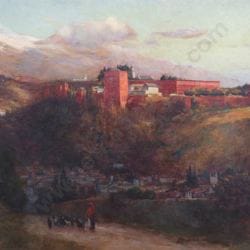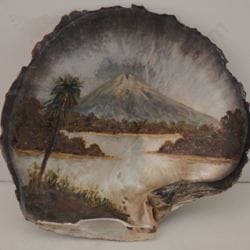The archaeological relics that have inspired this radical revision of ancient history are some carefully crafted tools and lumps of black and red rock that were used to make pigments.
Roughly 1.2m years ago, our distant ancestors began using a large, teardrop-shaped handaxe. At least 305,000 years ago, the people who lived around Lake Olorgesailie, had completely replaced that effective, but crude, axe with a varied array of specialist tools – awls, spear tips and scrapers – many of which were made using a black volcanic rock called obsidian.
Where did this obsidian come from? The evidence suggests that the nearest outcrops of obsidian were located 100 miles away. Given the volume of obsidian used around Lake Olorgesailie, anthropologist Alison Brooks believes it is unlikely that the locals commuted to pick up their obsidian. “We have thousands of pieces in one site that is smaller than most people’s kitchens. There has been a really major import of raw materials,” Brooks told The Atlantic magazine.
The discovery of coloured rocks at Olorgesailie supports Brooks’s view. One site contains 86 lumps of manganese ore, useful for producing dark brown or black pigments. Elsewhere, two lumps of iron minerals had been chiselled apart to extract a red powder which, when mixed with fat, would have produced paint. Like the obsidian, the pigment-producing rocks were imported from some distance away.
Cognitive and social behaviours
To import raw materials you need a trade network and a supply chain. And to create those you need a set of skills – technological innovation, long-term planning and symbolic representation – which we had previously assumed our ancestors developed much later on. These findings suggest that anatomically modern people – with large brains and a bipedal stance – started behaving in a recognisably modern way slightly more than 300,000 years ago.
In Potts’ view, “What we’re seeing in Olorgesailie is right at the root of homo sapiens. It seems that this package of cognitive and social behaviours were there from the outset.”
This breakthrough is one of several discoveries which, in the past two decades, have forced us to radically revise our ideas about the evolution of our species – and the capabilities of our earliest ancestors.
In 1999, a study by engineering firm Daniel, Mann, Johnson & Mendenhall found that the Great Pyramid in Giza took ten years to build, with 2.5m blocks being installed at the rate of three a minute, with no pulleys, wheels or iron tools.
Despite what such Hollywood blockbusters as The Ten Commandments might suggest, an enormous army of slaves did not build these ancient wonders. Many of the workers, archaeologist Mark Lehner believes, were fulfilling a social obligation – known as ‘bak’ – which was effectively a form of national service and, as such, applied even to dignitaries. The most astonishing aspect of this feat is that, despite having such rudimentary tools, the monuments are roughly as accurate as they would be if we built them today using modern construction methods and laser levelling. (The entire 53,000 square metre site at Giza was levelled to a consistency of a fraction of an inch.)
Lowest-cost nomadic pathways
Anthropologists, aided by algorithms, are also enriching our understanding of the first global supply chain, the original Silk Road that connected the Korean Peninsula to the Mediterranean Sea.
Historical accounts have this trade route opening up in the second century AD, protected by the armed might of China’s Han dynasty. Yet Michael Frachetti and his colleagues at the Washington University in St Louis were convinced that these routes were far older, and probably originated as pathways travelled by nomadic herders.
The algorithms previously used to map the Silk Road network were based on a “least cost” model – effectively the easiest path – developed for use in lowland areas with urban centres. This model, Frachetti argued, was hardly relevant when contemplating routes through mountains where the terrain was uneven and often barren. Adapting algorithms that tracked water flows across landscapes and identified the greenest landscapes, his team discovered pathways leading to 450 camps on the Silk Road.
Previous research has shown that nomadic sheep herders were roving the mountains of central Asia around 4,500 years ago. Their pathways, Frachetti believes, formed the original Silk Road. As these routes became more established, the nomads probably began to trade with each other and with the communities they encountered on their travels.
These discoveries are a salutary reminder that, in ancient times, supply chains were not only an economic stimulus, they were, in Brooks words, a way of spreading “the risk over a much wider landscape. There’s no other way these people can save for a future disaster. They don’t have crops or animals, they have friends. It’s part of a human way of life.”
| A Supply Management release | || April 05, 2018 |||





